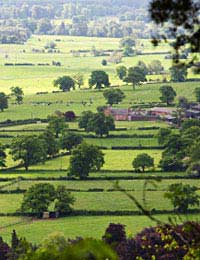DNA and Biodiversity Problems

While DNA technology is exciting in that it has provided numerous important and beneficial applications for humans, there are still issues that plague its progress and total acceptance from the public and scientific community. One such issue is its impact on biodiversity.
DNA, Genetic Modification and Biodiversity
DNA discovery has allowed scientists to develop genetic modification (GM) technology, which involves the insertion of desired genes from one organism into another, thereby providing the recipient organism with a new genome of a desired gene combination. Examples of GM technology include engineering a vegetable to withstand the cold or producing a coffee bean that is caffeine-free. The relative newness of the technology, however, means that it has been somewhat of a waiting game to understand the impact GM technology has on biodiversity.Understanding Biodiversity
Biodiversity refers to a wide variety of organisms - basically meaning different kinds of life. If a geographic area has a large range of different species, we would say that area is high in biodiversity. Even a wide variety within a species itself is considered to have a high biodiversity.When there is a high biodiversity, there tends to be a great deal of interaction between and within species. This high level of biodiversity can aid the ecosystem in maintaining health and can help it to resist any challenges that may arise in the environment. As such, we tend to use the level of biodiversity in an ecosystem to assess its health and well-being. Therefore, any threats to an ecosystem's biodiversity could cause numerous problems to the landscape itself as well as threaten the residing organisms. The impact of GM technology on biodiversity is clearly an important aspect to consider before this type of technology can be fully accepted and promoted.
Weeds, GM Technology and Biodiversity
Farmers generally need to address various weeds and threats to their crops. When a farmer grows crops, he or she is typically removing wild plants that grow on the farm. This strategy protects the crops because if weeds grow beside the crops, they will all be competing for vital life-giving sources of water, sunlight and nutrition. If weeds prevail, crop yields and quality will be threatened. Yet, some wild growth can still be beneficial because such weeds can be appealing to some of the animals that we know can reduce pest activity. If a farmer's growing methods are carefully considered and organised, there can be a use for a reasonable amount of wild growth while crops still obtain the conditions necessary to thrive. With such a delicate balance required for healthy, thriving fields, it is no wonder that GM technology has to be scrutinised to ensure it does not harm the biodiversity necessary to utilise the benefits of weeds and pest-controlling animals while safeguarding the success of crop yields and quality.Gene Transfer and Compromised Biodiversity
One concern regarding gene transfer is that if genes are transferred to a relative of the plant's species, then the recipient plant may assume a totally different ecological role. This may lead to competition between species and could threaten the livelihood of one species while increasing the population of another species.Crops Engineered to be Herbicide Resistant
When crops are engineered to tolerate herbicides or pesticides, their presence obviously will affect the level of weeds and other wild plants in the field. If too many weeds are destroyed, this could affect food for animals or it could increase the number of disease-causing pests. Trials must be undertaken in controlled conditions to determine if a specific GM crop may harm biodiversity. The task is not an easy one either because such conditions are difficult to mimic for accurate results in other environments or to apply to a large-scale operation.GM Seeds and Biodiversity
There have been concerns that by engineering seeds to have specific genes, we will lose biodiversity because there will be only a few organisms with many traits rather than many organisms with fewer traits. Still, companies engineering such seeds are actually more likely to engineer several different species with a new gene rather than just one, so variety will not necessarily be lowered. At the same time, it is an area that we should monitor to ensure that biodiversity continues to thrive.Protecting biodiversity should be a priority for all farmers, scientists, and producers of GM seeds. In fact, the public should make it a priority as well because pressure from the public to protect our land can make a difference to policy makers and those who monitor and influence GM technology and its applied practices. Our interest and support can make a difference in keeping biodiversity safe and thriving.


Re: How was DNA Discovered?
DNA is not a real thing, the earth is flat, the sun is blue
Re: An Overview of DNA Functions
I tried to extract DNA from my refrigerator, now I have no refrigerator and my food is rotting.
Re: The Properties of DNA
what are 5 characteristics of DNA?
Re: How was DNA Discovered?
betty for the last time im trying to sleep bugger of babe
Re: How was DNA Discovered?
It is past you bedtime winnie pleas go to bved now or no france for you go back to easter island looser!!!
Re: How was DNA Discovered?
My bed time is at 9:00 and it is 9.01 in indea at the moment> i am sooooooooo naughty
Re: How was DNA Discovered?
ICE ICE DAVEY
Re: How was DNA Discovered?
This sorkis absalutely propostuous I found out about DNAfirst these loosers lied
Re: How was DNA Discovered?
meow
Re: How was DNA Discovered?
this workis realy interresting i would love to disscus more about this with you